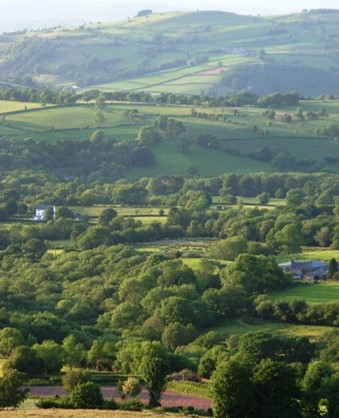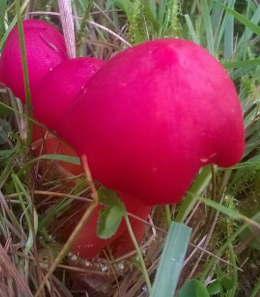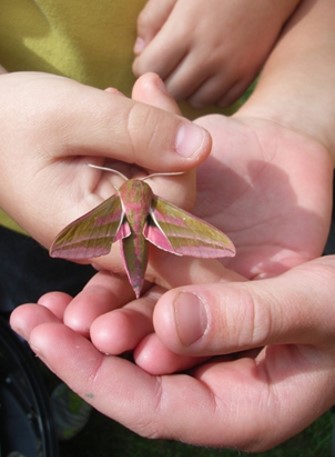Nature in Carmarthenshire
Biodiversity greatly influences the character of our landscape and the experience of the people who live in Carmarthenshire. The county is justly celebrated for its natural environment, including magnificent coastal sand dunes, quiet estuaries, steep wooded valleys and rugged uplands. Throughout much of the rest of the county there is a network of habitats that support biodiversity: streams and rivers, woodland, hedgerows and species-rich grassland. The sea and seabed around the Carmarthenshire coast are also rich in species, including harbour porpoise. Where collieries and heavy industry once existed, old industrial sites can now flourish with wildlife. Gardens in towns and villages are increasingly important for wildlife as natural habitats elsewhere are being lost or degraded.
The range of species recorded in the county reflects the diverse range of habitats within Carmarthenshire and the ability of species to adapt to a variety of conditions. Some species are common and others much scarcer, relying on a specific habitat to survive.
Read more about Carmarthenshire biodiversity here

History
First set up in 1998 the Carmarthenshire Nature Partnership is made up of a number of partners with a depth of knowledge, experience and enthusiasm for the county’s biodiversity. The Partnership is individual to our area and for over 20 years has provided probably the only local opportunity for conservation organisations, ecologists and recorders to network, share experiences and develop projects in partnership. The individual conservation organisations within the Partnership, make up a broad spectrum of expertise on a wide range of species and habitats (including our best and least known wildlife).
Contact the Carmarthenshire biodiversity coordinator to find out more about the Carmarthenshire Local Nature Partnership and how you can help nature in Carmarthenshire.

Our Objectives
The Carmarthenshire Nature Recovery Action Plan has a focus on ecological resilience with connectivity as a central theme. This is part of a vision to restore and create better connected networks of habitats within the county, as well as networks of information sharing to inform action by a range of participants. A resilient natural environment in the county contributes the desire for a healthy, safe and economically sustainable Carmarthenshire.
A NRP is being developed based on the objectives of the national plan which address the issues that are driving the decline in biodiversity, and to support recovery:
- Engage and support participation and understanding to embed biodiversity throughout decision making at all levels;
- Safeguard species and habitats of principal importance and improve their management
- Increase the resilience of our natural environment by restoring degraded habitats and habitat creation;
- Tackle key pressures on species and habitats;
- Improve our evidence, understanding and monitoring

How are we going to achieve it
The Carmarthenshire Nature Partners will work together to identify priorities areas for action within Carmarthenshire that reflect the objectives of the Welsh Nature Recovery Action Plan and the opportunities identified within the South West Area Statement. We must consider what any partnership can reasonably achieve and where the challenges and opportunities are. This will influence the structure of any proposals, guide realistic local objective setting and help focus where the most effective action can take place.
The Carmarthenshire State of Nature Report 2024 is a health check on how Carmarthenshire’s
habitats and species are faring and will be a valuable resource for nature conservation across the county. It will inform and target delivery, and provides a baseline for future State of Nature Reports.
The report has been compiled by the Carmarthenshire Local Nature Partnership highlighting the crucial role of Local Nature Partnerships in Wales. The Report also acknowledges the need to work together, across all sectors of society and business to deliver a nature rich society that benefits us all.
You can download a summary report or the full report from the following link
The work of the partners, and the projects they undertake, deliver outcomes that help to conserve and enhance our natural environment and often deliver multiple benefits that improve the well-being of the people that live here and contribute to the economy of the county.
If we are serious about nature recovery, it requires action from us all and for organisations and individuals to work together in partnership - including land owners, government agencies, wildlife conservation groups, local authorities and industry.
Local people, communities and schools can make a difference as well and it is a role of all the partners to raise awareness and work with communities on projects that benefit biodiversity – and the people involved in local action
A good starting point are the “Making Space for Nature” resources- you will find lots of tips on how individuals, groups and organisations can make space for nature and help provide vital habitats for our plants and animals.
Places to see nature in Carmarthenshire
There is always somewhere where you can enjoy nature in Carmarthenshire, whatever time of year it is. From Local Nature Reserves to sites of international importance, many of these sites are open to the public.
Here are some of highlights in the county - you can view more here
Wildfowl and Wetlands Centre Llanelli
A 450 acre mosaic of lakes, scrapes, stream and lagoons adjoining the salt marshes and the scenic Barry Inlet
Waun Las National Nature Reserve
A beautiful mosaic of wildflower-rich hay meadows and pasture
Dinefwr Park
A site of Special Scientific Interest (SSSI) on the outskirts of Llandeilo and the first parkland National Nature Reserve) in Wales
Troserch Woods
A community woodland for walkers, cyclists and horse- riders and with abundant wildlife interest.
Nature reserves are managed by a range of conservation organizations that work in the county and most have information on site that explains more about the habitats and wildlife you can see there. Carmarthenshire also has an extensive network of footpaths and countryside walks throughout the county.
Highlights
- Carmarthenshire has more marshy grassland than any other county in Wales. This important habitat supports the marsh fritillary butterfly, one of the most rapidly declining butterflies in Europe.
- Pant-y-llyn, near Carmel on the limestone ridge, is the only known example in mainland Britain of a ‘turlough’ – a seasonal lake with no inlet or outflow streams and fed entirely by groundwater.
- Water vole numbers have declined dramatically across the UK, but Carmarthenshire continues to support important populations around Llanelli, Laugharne and Pendine.
- Sausage beard lichen was not recorded in the county until 2006. Since then recording effort has increased the records of this internationally important species, which is highly sensitive to pollution.
- The endangered strandline beetle is now restricted to a few beaches in Carmarthen Bay, including Cefn Sidan (Pembrey) and Laugharne–Pendine. The beetle is an indicator of the health of strandline communities
- The Mid Wales Red Squirrel Partnership was established in 2002.The Partnership aims to expand and protect the unique population of red squirrels in mid Wales
Key contact
Conservation Section
Carmarthenshire County Council
Civic Offices
Crescent Road
Llandeilo
SA19 6HW
Phone: 01558 825390
Email: [email protected]
Website: carmarthenshire.gov.wales















